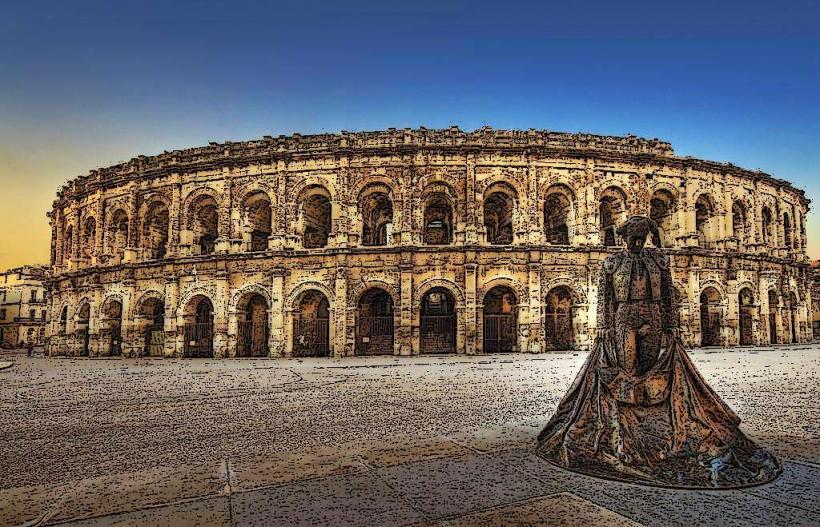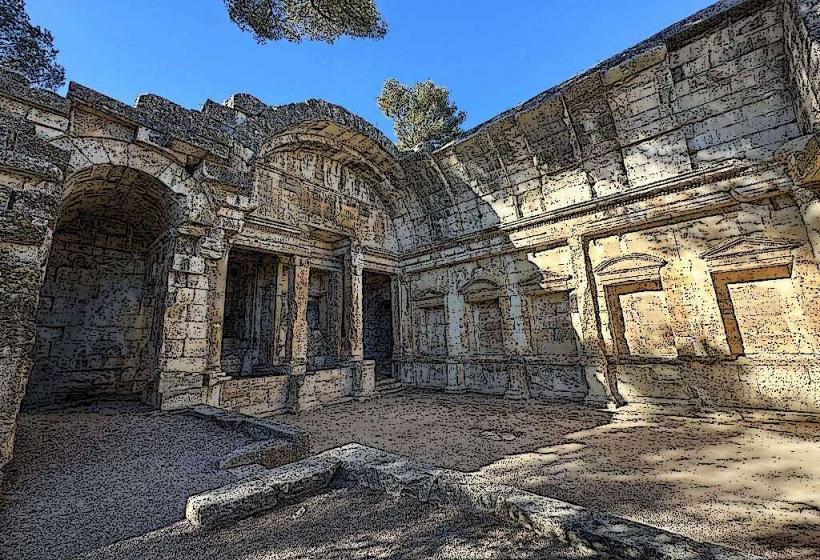Information
Landmark: Maison CarreeCity: Nimes
Country: France
Continent: Europe
The Maison Carrée is one of the best-preserved examples of Roman architecture in the world, located in the heart of Nîmes, France. Built around 16 BCE during the reign of Emperor Augustus, it is a former Roman temple and one of the most iconic landmarks in the city. The Maison Carrée is admired not only for its pristine condition but also for its elegant design, which has influenced architectural styles throughout history, particularly during the Neoclassical period.
Key Features and History of the Maison Carrée
1. Architectural Design and Structure
- The Maison Carrée is an example of the Corinthian-style temple, characterized by its grandeur and decorative details.
- The temple measures 26 meters long, 14 meters wide, and is supported by a series of columns on the front (which are Corinthian columns), each standing about 7 meters tall. These columns form a portico (a porch) that leads into the inner sanctuary of the temple.
- The structure is made of limestone, which has helped it retain its impressive appearance through the centuries.
- The facade of the Maison Carrée is extremely well-preserved, and its pediment (the triangular top of the building) and columns are some of the most notable features, demonstrating the Roman emphasis on symmetry, proportion, and harmony.
2. Function and Purpose
- Originally, the Maison Carrée was a Roman temple dedicated to the gods, most likely to the Julian family or the Emperor Augustus. It is believed to have been built in honor of the emperor's two grandsons, Gaius and Lucius Caesar, who were adopted by Augustus but tragically died young.
- The building was part of Nîmes’ urban development during the reign of Augustus, reflecting the Roman Empire’s architectural and cultural influence in the region.
- Although it was a temple, it was also used for civic and political purposes. Like many Roman temples, it likely served as a place for local officials to give speeches, hold ceremonies, and display their power and influence.
3. Preservation and Survival
- One of the most remarkable aspects of the Maison Carrée is its excellent preservation. Unlike many other Roman buildings, it has withstood the ravages of time, war, and natural disasters.
- Over the centuries, the temple was repurposed. During the Middle Ages, it was converted into a church, which helped protect it from destruction. Later, in the 18th century, it was restored and turned into a neoclassical model, becoming a symbol of the city's Roman heritage.
- It’s one of the few Roman temples to remain intact in such a well-preserved condition, which is why it is such a significant historical monument.
4. Modern-Day Usage
- Today, the Maison Carrée functions as a museum and a key point of interest for visitors in Nîmes. It houses an exhibit on the history of the Roman city of Nîmes and the surrounding area. Visitors can explore the temple’s historical background and significance.
- The exhibitions inside the Maison Carrée are interactive, featuring displays about Roman architecture, the temple’s role in Nîmes, and the ancient city’s development. The temple is part of the broader Roman history theme that the city celebrates.
- The building is a perfect example of how ancient structures can be preserved and adapted for modern use while retaining their historical integrity.
5. Neoclassical Influence
- The Maison Carrée had a significant influence on later architectural styles, particularly during the Neoclassical period of the 18th and 19th centuries. Architects like Thomas Jefferson drew inspiration from the Maison Carrée for the design of buildings such as the Virginia State Capitol and the United States Capitol.
- Its symmetrical design and classical style became key influences on many buildings in the Western world, emphasizing the Roman ideals of order, symmetry, and balance.
6. Visitor Experience
- Visitors to the Maison Carrée can explore both its exterior and interior. The exterior is open to the public, allowing people to admire its impressive columns and intricate architectural details. The interior has been carefully restored to maintain its Roman design and features educational exhibits that explain its history.
- The temple stands in Place de la Maison Carrée, a beautiful square in Nîmes, surrounded by cafes and shops, making it a perfect spot to enjoy the lively atmosphere of the city while reflecting on its ancient history.
7. Cultural Significance
- The Maison Carrée is a symbol of Nîmes’ Roman heritage and is often referred to as the “jewel of Nîmes.” It represents the city's long-standing connection to the Roman Empire and is a source of pride for locals and a must-see for tourists.
- The building’s classical design reflects the influence of Rome on the culture, architecture, and political systems of the ancient world. It is a testament to Nîmes' importance as a Roman city and a major cultural hub in the empire.
Conclusion
The Maison Carrée is a masterpiece of Roman architecture and a key part of Nîmes' identity. With its well-preserved columns, beautiful proportions, and historical significance, it provides a fascinating glimpse into the past while remaining an integral part of Nîmes' modern-day landscape. Whether you’re an architecture enthusiast, a history buff, or simply someone who appreciates timeless beauty, a visit to the Maison Carrée is an essential experience when exploring Nîmes.




